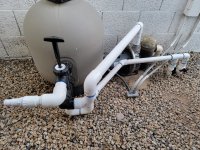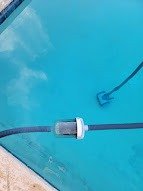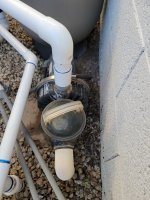Hi TFP members,
Long time no see. I am at the end of my wits with my current situation, apologies in advance for the length. I recently replaced all the plumbing (above ground) at my equipment pad, including the expensive Hayward valve/ports coming off my Hayward pro series S244SV sand filter. I kept all PVC diameters and joints the same as previous layout. I removed, lubed and/or replaced every o-ring on my pump and filter lids/connections, and in-line leaf canister. No leaks, everything ran normal for a few weeks. Then my trusty old Navigator stopped running. It's 8+ years old and I've rebuilt it twice, so figured time to buck up and replace. Bought the Zodiac MX6, but after installing with new hose line and the Zodiac cyclonic leaf canister, it too would not run. I would find the vac floating near the top of the pool after the pump runs for a few hours. I read some reviews about customers receiving duds, so returned and purchased the Hayward Aquanaut instead, with a new Hayward vac line. The Aquanaut runs, although very slowly, and occasionally floats to the surface after several hours of the pump running. Something is creating air in the vac line...
My cousin is a pool guy and came over to take a look yesterday. Here's a rundown of what we know, working backward from the Aquanaut vac head:
-The Aquanaut and hose line are not the source of the air leak(s) (when totally submerged from end to end with pump off, there are no bubbles)
-The in-line leaf canister is not the source either (although serves as the visual point in which we can see air bubbles gathering)
-The suction in the skimmer basket (I only have one suction side port- this is where vac hose connects) seems strong, no vortex allowing air in due to hose connection there and appropriate water level
-The pump basket primes normally and when pump running there is almost no air under the lid, a tiny bubble maybe, that's always been there.
-The two returns are pushing water normally while pump is running with no air bubbles. However upon start up of pump there is definitely air in them that gets purged out, then settles down.
-I have not touched the pump except to check the impeller, which was in good condition. Buttoned up, no leaks we can see
-When I switch off the pump, you can hear a "whoosh" of water leaving the system and the water level in the pump basket goes down significantly
Incomplete conclusion- I have a suction side leak somewhere between my pump and the skimmer basket. I hope it's not underground, the only hypothesis I have left is the pump somewhow has an air leak. When I was rebuilding the plumbing, I needed to do a backwash and hooked up a garden hose, which was a bad idea as the water pressure is far too strong to use something of that narrow diameter and I'm wondering if the pump internals were damaged when I ran it. The pump is also extremely old and I've been hoping to string it along a bit longer. It is an old "Challenger" 3/4 single speed model. My only guess is somehow it's letting air in the system, otherwise it's an underground issue.
Questions- Is a pump air leak common? Do pumps crack or somehow contribute a small amount of air that compiles over the run time down the vac line? Why does the pump basket fill 99% full of water while it runs? What else should I troubleshoot? I don't want to spend $$$ on a new pump only to find out I still have another problem.
Thank you!
Long time no see. I am at the end of my wits with my current situation, apologies in advance for the length. I recently replaced all the plumbing (above ground) at my equipment pad, including the expensive Hayward valve/ports coming off my Hayward pro series S244SV sand filter. I kept all PVC diameters and joints the same as previous layout. I removed, lubed and/or replaced every o-ring on my pump and filter lids/connections, and in-line leaf canister. No leaks, everything ran normal for a few weeks. Then my trusty old Navigator stopped running. It's 8+ years old and I've rebuilt it twice, so figured time to buck up and replace. Bought the Zodiac MX6, but after installing with new hose line and the Zodiac cyclonic leaf canister, it too would not run. I would find the vac floating near the top of the pool after the pump runs for a few hours. I read some reviews about customers receiving duds, so returned and purchased the Hayward Aquanaut instead, with a new Hayward vac line. The Aquanaut runs, although very slowly, and occasionally floats to the surface after several hours of the pump running. Something is creating air in the vac line...
My cousin is a pool guy and came over to take a look yesterday. Here's a rundown of what we know, working backward from the Aquanaut vac head:
-The Aquanaut and hose line are not the source of the air leak(s) (when totally submerged from end to end with pump off, there are no bubbles)
-The in-line leaf canister is not the source either (although serves as the visual point in which we can see air bubbles gathering)
-The suction in the skimmer basket (I only have one suction side port- this is where vac hose connects) seems strong, no vortex allowing air in due to hose connection there and appropriate water level
-The pump basket primes normally and when pump running there is almost no air under the lid, a tiny bubble maybe, that's always been there.
-The two returns are pushing water normally while pump is running with no air bubbles. However upon start up of pump there is definitely air in them that gets purged out, then settles down.
-I have not touched the pump except to check the impeller, which was in good condition. Buttoned up, no leaks we can see
-When I switch off the pump, you can hear a "whoosh" of water leaving the system and the water level in the pump basket goes down significantly
Incomplete conclusion- I have a suction side leak somewhere between my pump and the skimmer basket. I hope it's not underground, the only hypothesis I have left is the pump somewhow has an air leak. When I was rebuilding the plumbing, I needed to do a backwash and hooked up a garden hose, which was a bad idea as the water pressure is far too strong to use something of that narrow diameter and I'm wondering if the pump internals were damaged when I ran it. The pump is also extremely old and I've been hoping to string it along a bit longer. It is an old "Challenger" 3/4 single speed model. My only guess is somehow it's letting air in the system, otherwise it's an underground issue.
Questions- Is a pump air leak common? Do pumps crack or somehow contribute a small amount of air that compiles over the run time down the vac line? Why does the pump basket fill 99% full of water while it runs? What else should I troubleshoot? I don't want to spend $$$ on a new pump only to find out I still have another problem.
Thank you!
Last edited:




